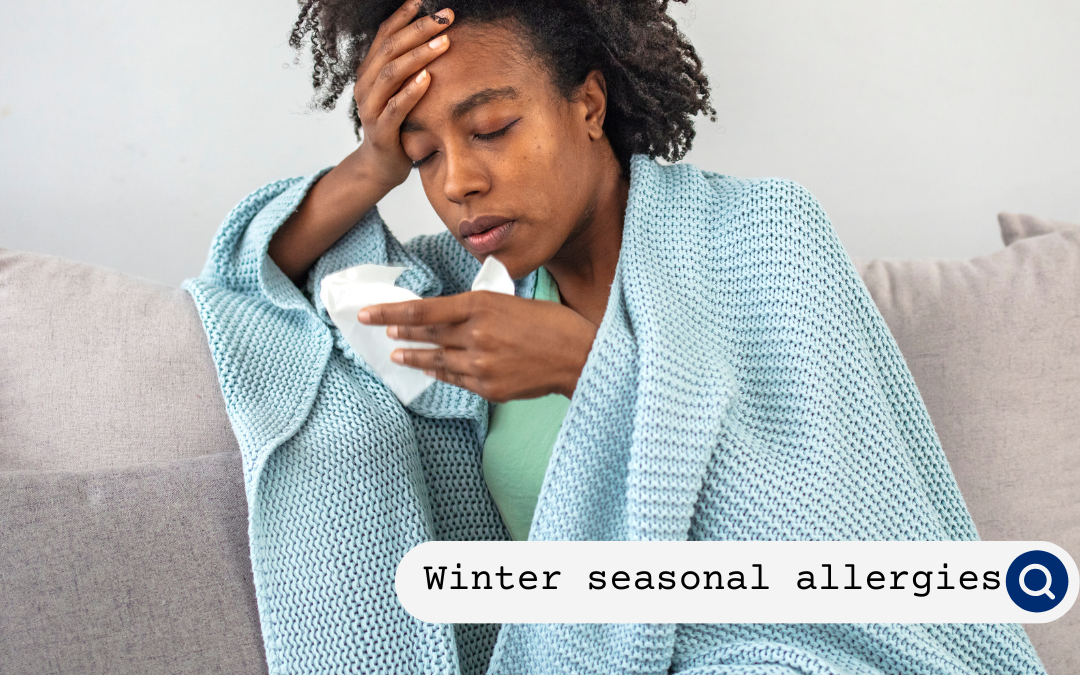As the weather turns colder, you may expect your allergy symptoms to subside. After all, the usual culprits—pollen, dust mites, and mold—are often associated with warmer months. However, many people experience winter seasonal allergies, and the symptoms can be just as bothersome as those in spring and fall. If you’re wondering why your allergies are flaring up in the winter, or how to get them under control, we’re here to provide answers and solutions.
What Are Winter Seasonal Allergies?
Winter seasonal allergies are immune system responses to specific allergens that thrive during the colder months. While you might assume that allergies are tied to warm weather, many triggers are more active during the winter than you might think. Common winter allergens include:
1. Indoor Allergens
During the winter, people tend to spend more time indoors, where they are exposed to indoor allergens. These can include:
-
Dust mites: Dust mites thrive in warm, humid environments. During winter, the air inside homes tends to be drier due to heating systems, but dust mites continue to thrive in upholstered furniture, bedding, and carpets.
-
Mold: Mold can grow in areas with high humidity, such as bathrooms, kitchens, and basements. With less ventilation in winter, mold spores can accumulate, triggering allergic reactions.
-
Pet dander: As people spend more time indoors, they are often exposed to pet dander. Animals that shed their fur or skin flakes (such as cats, dogs, and rodents) can contribute to allergy symptoms, especially when ventilation is limited during colder months.
-
Cockroach allergens: In some regions, cockroaches are more active during winter as they seek warmth in homes. Their droppings and body parts can trigger allergic reactions.
2. Outdoor Allergens
While pollen levels are low in the winter, certain outdoor allergens can still cause issues, particularly when the weather is dry or when temperatures fluctuate. Some common winter outdoor allergens include:
-
Tree pollen: Certain trees, such as birch and cedar, release pollen in the winter months, particularly in areas with milder winter climates. This can cause sneezing, congestion, and other allergic symptoms in sensitive individuals.
-
Cold, dry air: While not an allergen itself, the cold and dry air during winter can exacerbate allergy symptoms. The air can dry out nasal passages, making them more sensitive to allergens like dust, mold, and pet dander.
3. Increased Use of Heating Systems
Heating systems can also contribute to winter allergies. Forced-air heating systems, for example, can blow dust and allergens into the air. Similarly, space heaters and fireplaces can stir up dust particles and indoor pollutants, which may cause allergic reactions in sensitive individuals.
How to Identify Winter Allergies
The symptoms of winter allergies are similar to those experienced during other seasons. Common signs of an allergic reaction include:
- Sneezing
- Runny or stuffy nose
- Itchy or watery eyes
- Coughing
- Wheezing or difficulty breathing
- Postnasal drip (the sensation of mucus dripping down the back of the throat)
- Fatigue (from poor sleep due to nasal congestion)
If you find that these symptoms only appear or worsen during the winter months and improve when you are outside, it is likely that you are dealing with winter allergies.
How to Control Winter Allergies
While winter allergies can be tricky to manage, there are several steps you can take to reduce your exposure to allergens and control your symptoms. Here’s what you can do:
1. Keep Your Home Clean and Dust-Free
Since you’re spending more time indoors, it’s essential to maintain a clean environment. Dusting and vacuuming regularly can help reduce exposure to dust mites and other indoor allergens. Here are some tips for reducing dust buildup:
-
Use a vacuum cleaner with a HEPA filter to capture fine dust particles.
-
Dust surfaces with a damp cloth to prevent dust from becoming airborne.
-
Wash your bedding, pillowcases, and blankets in hot water weekly to kill dust mites.
-
Consider removing carpets or rugs, especially in bedrooms, as they can trap dust and allergens.
2. Use a Humidifier
Dry air in the winter can dry out your nasal passages, making them more susceptible to irritation from allergens. Using a humidifier can help keep the air moist and alleviate dryness in your nose and throat. Make sure to clean the humidifier regularly to prevent mold growth.
3. Control Mold Growth
Mold is a common winter allergen, so it’s important to keep humidity levels in check and prevent mold from growing indoors. Some steps to prevent mold growth include:
- Use a dehumidifier in damp areas like bathrooms and basements.
- Fix any leaks in the roof, windows, or plumbing to prevent water from accumulating.
- Clean any visible mold from walls, ceilings, and other surfaces using mold-killing products.
- Ensure proper ventilation in high-humidity areas by using exhaust fans or opening windows when possible.
4. Limit Pet Dander Exposure
If you have pets, it can be difficult to avoid exposure to pet dander. However, there are ways to minimize the effects:
- Keep pets out of bedrooms and off upholstered furniture.
- Wash your pet regularly to reduce shedding and dander.
- Clean pet bedding frequently.
- Use an air purifier with a HEPA filter to help remove pet dander from the air.
5. Filter the Air
Invest in a high-quality air purifier for your home, especially in your bedroom, living room, or any other areas where you spend a lot of time. Look for a purifier with a HEPA filter, which can remove particles as small as 0.3 microns (including dust, mold spores, pet dander, and pollen). Also, replace air filters in your heating system regularly to prevent the spread of allergens.
6. Take Allergy Medications
Over-the-counter antihistamines, decongestants, and nasal sprays can help relieve the symptoms of winter allergies. Antihistamines block the histamine response that causes sneezing, itching, and runny noses. Decongestants can help clear up nasal congestion, and nasal sprays can help reduce inflammation in the sinuses.
If your symptoms persist despite using over-the-counter medications, you may need a prescription allergy medication or an allergy shot (immunotherapy). It’s a good idea to consult with an allergist to discuss the best treatment plan for your specific symptoms.
7. Stay Warm, But Ventilate
While it’s important to stay warm in the winter, make sure your home is well-ventilated. Opening windows occasionally can help clear out stale indoor air and prevent allergens from building up. However, avoid staying outside for extended periods when the air is particularly cold and dry, as this can exacerbate symptoms.
8. Be Mindful of Outdoor Allergens
While pollen is not as prevalent in winter, certain tree species (such as birch and cedar) release pollen during the colder months, particularly in areas with milder winters. Check local pollen forecasts and try to limit outdoor activities on days when pollen levels are high. Wearing a scarf over your nose and mouth when you go outside can help reduce exposure to cold air and allergens.
If your symptoms are persistent or severe, consult with an allergy provider to explore additional treatment options.
By taking proactive steps, you can keep your allergies under control and enjoy the winter season to the fullest!





